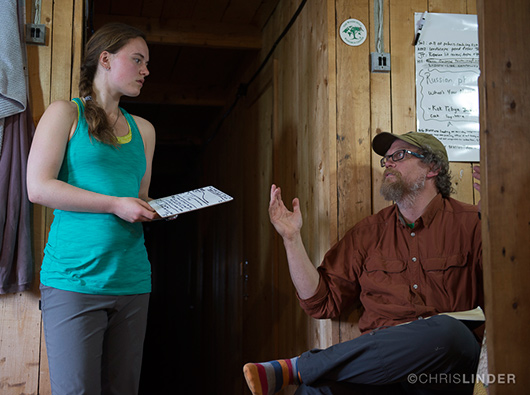There was an amazing moment, after I finished explaining my draft graphs for the American Geophysical Union (AGU) Fall Meeting to Sue, John, and Mike over Skype last week, when John commented “I thought you explained that really clearly.”
Me? Explained it clearly? Oh what a relief.
I have no problem giving rehearsed talks. But extemporized explanations are challenging to me. Thoughts do not emerge in a sequential stream, but instead in a madcap rush, like the chaos of water from a bursting dam. I start in the middle, jump sideways, conclude, then give introductory context, and then wonder why no one has followed my explanation. John Schade once remarked (only half jokingly) that he did not want to know what the inside of my brain is like. And now here he was, complimenting my explanation. The work I have put in this semester not only into data analysis and literature reviews but also into explaining, and discussing, and communicating what I am doing is paying off.

John Schade provides guidance on the barge.
I don’t think I could be learning a more important lesson. Science must become a part of public understanding and a part of policy decision making. I am beginning to improve at communication, and in the long term, that will help me be a better scientist.
In the short term, I will need to communicate clearly at AGU when I present my poster in December. I will need to not only explain the research I did, but also answer questions from scientists who know far more about this field than I do. In some ways, it feels as though I am preparing for a debutante ball–an entrance into the scientific society that I wish to be a part of. I already have plans for coffee with an incredible scientist who studies photochemical degradation of Arctic steam carbon, and have made contact with several other researchers whose papers I have read and whose work I admire. In the middle of finalizing graphs and formatting poster text, I am also reading papers by the people I will be meeting, because in making a first impression on potential graduate school advisors and research PIs, I want to be able to communicate my interest in and knowledge about their work.
In the midst of the whirlwind of preparing for finals and preparing for AGU, I have to stop sometimes and marvel. Though I am currently focusing on how to communicate, I also do not want to forget that what I have to communicate is a complete story. The second set of data from the incubations I set up in Russia was sent to me by team members who had stayed behind when the core group left. After puzzling and learning how to find the story inside multiple types of data, I found that I had a complete picture to communicate. It is a very small picture, yes–a snapshot of carbon breakdown processes and their results in a few small watersheds in the middle of the far north–but it tells a story. I am grateful that I got to peek into the workings of these streams and see a coherent picture, and proud that I learned how to tease apart the strands and see the underlying pattern. At AGU, I will not only be able to continue practicing my communication skills, I will also get to communicate this story that I uncovered. In the stressful countdown to the conference, I do not want to lose track of those dual triumphs–first that I am improving in such an important skill, and second that I have learned to see the story inside what I thought was disparate data. I have come so far in my knowledge and abilities from when I stepped on the plane to go to Russia. When I take a moment and really think about it, it is amazing.



